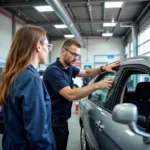Bubbling paint on your car is more than just an eyesore; it’s a sign of underlying issues that can lead to rust and further damage. Understanding how to permanently repair bubbling paint is essential to preserving your car’s value and appearance. This guide will delve into the causes, solutions, and preventive measures for bubbling car paint.
Understanding the Causes of Bubbling Paint
Bubbling paint, often called “paint blisters,” occurs when the paint film loses adhesion to the underlying surface. Several factors contribute to this, including:
- Moisture: This is the most common culprit. Water can seep under the paint through chips, cracks, or poorly sealed seams. Once trapped, the moisture creates pressure, causing the paint to lift and bubble.
- Rust: Rust formation underneath the paint pushes it outwards, creating bubbles. This is particularly problematic as rust weakens the metal and requires more extensive repair.
- Poor Paint Application: Improper surface preparation, such as inadequate cleaning or priming, can prevent the paint from adhering properly, leading to bubbling over time.
- UV Damage: Prolonged exposure to sunlight can degrade the paint’s chemical bonds, making it brittle and prone to lifting.
- Impact Damage: Stones, debris, or even minor accidents can chip the paint, allowing moisture to penetrate and initiate the bubbling process.
How to Permanently Fix Bubbling Paint: A Step-by-Step Guide
Repairing bubbling paint requires a methodical approach. Here’s a detailed guide:
- Assess the Damage: Determine the extent of the bubbling and identify the underlying cause. This will inform your repair strategy.
- Gather Your Supplies: You’ll need sandpaper (various grits), primer, paint that matches your car’s color, clear coat, masking tape, plastic sheeting, a scraper, a sanding block, and safety glasses.
- Prepare the Area: Wash and dry the affected area thoroughly. Mask off the surrounding areas to protect them from overspray.
- Remove the Bubbling Paint: Use a scraper to carefully remove all loose and bubbling paint. Sand the area down to bare metal, feathering the edges to blend with the surrounding paint.
- Treat Rust (If Present): If you find rust, use a rust converter or remover to neutralize it. Follow the product instructions carefully.
- Apply Primer: Apply a thin, even coat of automotive primer to the bare metal. This provides a smooth surface for the paint to adhere to and protects against future rust.
- Sand the Primer: Once the primer is dry, lightly sand it with fine-grit sandpaper to create a smooth surface.
- Apply Paint: Apply several thin coats of paint that matches your car’s color, allowing each coat to dry before applying the next.
- Apply Clear Coat: After the final coat of paint has dried, apply a clear coat to protect the paint and enhance its shine.
- Final Touches: Remove the masking tape and allow the clear coat to cure completely.
Preventing Future Paint Bubbling
Preventing bubbling paint is easier than repairing it. Here are some preventative measures:
- Regular Washing and Waxing: Keeping your car clean and waxed helps protect the paint from the elements and prevents moisture penetration.
- Promptly Repair Chips and Scratches: Address any paint damage as soon as possible to prevent moisture from seeping underneath.
- Store Your Car in a Garage: Protecting your car from the elements can significantly reduce the risk of paint damage.
- Inspect Your Car Regularly: Regularly check for signs of bubbling paint, especially in areas prone to moisture accumulation.
Professional vs. DIY Repair
While DIY repairs can save money, complex bubbling paint issues, especially those involving extensive rust, are best handled by professionals. They have the expertise and tools to ensure a lasting repair.
“Addressing bubbling paint early is crucial,” says renowned automotive expert, Dr. Robert McMillan, Ph.D. “Ignoring the problem can lead to significant rust damage, requiring costly repairs down the line.”
Conclusion
Permanently repairing bubbling paint on your car requires understanding the underlying causes and implementing the correct repair procedures. By following the steps outlined in this guide and taking preventative measures, you can keep your car looking its best and protect it from further damage. Remember, addressing bubbling paint quickly is key to preventing more serious problems down the road.
FAQ
- Can I paint over bubbling paint? No, painting over bubbling paint will not solve the problem. The underlying issue needs to be addressed first.
- How long does it take for bubbling paint to rust? This depends on the environment and the severity of the bubbling. However, rust can develop relatively quickly once moisture has penetrated the paint.
- Is bubbling paint covered by insurance? This depends on your insurance policy and the cause of the bubbling.
- What type of paint should I use for car repair? Use automotive paint specifically designed for your car’s make and model.
- How can I match my car’s paint color? Your car’s paint code can usually be found on a sticker inside the driver’s side doorjamb.
- What is the best way to remove rust from a car? Rust can be removed using a rust converter, remover, or by sanding.
- How long does it take for car paint to cure? This depends on the type of paint and the environmental conditions, but generally, it takes several days for paint to fully cure.
Common Situations and Questions:
- Bubbling paint around wheel wells: This is often caused by road salt and debris impacting the paint.
- Bubbling paint on the hood: This can be due to engine heat, UV damage, or rock chips.
- Bubbling paint on the roof: This is often caused by UV damage or hail.
Further Resources on CarRepairOnline:
- How to Repair Scratches on Your Car
- Choosing the Right Car Wax
- Understanding Car Paint Protection
For any assistance, please contact us via WhatsApp: +1(641)206-8880, Email: [email protected]. We have a 24/7 customer support team.


